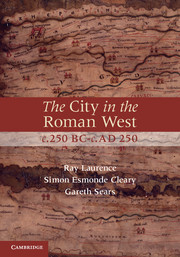Book contents
- Frontmatter
- Contents
- Illustrations
- Preface
- Introduction
- 1 The creation of an urban culture
- 2 Colonisation and the development of Roman urbanism
- 3 City foundation, government and urbanism
- 4 The reception of Roman urbanism in the West
- 5 Town planning, competition and the aesthetics of urbanism
- 6 Defining a new town: walls, streets and temples
- 7 Assembling the city 1: forum and basilica
- 8 Assembling the city 2: baths and urban life
- 9 Assembling the city 3: theatres and sacred space
- 10 Assembling the city 4: amphitheatres
- 11 The Roman city in c. AD 250: an urban legacy of empire?
- Bibliography
- Index
9 - Assembling the city 3: theatres and sacred space
Published online by Cambridge University Press: 05 June 2012
- Frontmatter
- Contents
- Illustrations
- Preface
- Introduction
- 1 The creation of an urban culture
- 2 Colonisation and the development of Roman urbanism
- 3 City foundation, government and urbanism
- 4 The reception of Roman urbanism in the West
- 5 Town planning, competition and the aesthetics of urbanism
- 6 Defining a new town: walls, streets and temples
- 7 Assembling the city 1: forum and basilica
- 8 Assembling the city 2: baths and urban life
- 9 Assembling the city 3: theatres and sacred space
- 10 Assembling the city 4: amphitheatres
- 11 The Roman city in c. AD 250: an urban legacy of empire?
- Bibliography
- Index
Summary
The theatre as an element of urbanism has its origins in the Greek cities of the fifth century BC and was to become an important feature of the cities of Campania and other parts of central Italy by the end of the second century BC. Combined with the fact that the first stone theatre, that of Pompey, was not built in Rome till the 50s BC and was followed by the construction of two further stone theatres, those of Marcellus and Balbus, by the close of the first century BC, this might suggest that the theatre was a building that was not characteristic of the Roman city. Indeed, the theatre does not seem to have become an essential urban element in the cities of Roman Spain or Britain. Yet, in Italy, North Africa and Gaul, the theatre was a feature of the urban landscape and one recognised by Vitruvius as a structure to be erected in the cities of the empire of Augustus. In Chapter 7 we examined the link between the forum and basilica complexes, which are prominent in Vitruvius’ text, and their civic and religious functions in the political landscape of the Roman city. That space was shown to be part of the urban formation that created a sense of urbanness that was reproduced across the Roman Empire in the West. The forum was a sacred space, but there were others in the city too. Traditional approaches and ideas as to how to understand or approach theatres and their part in the creation of sacred space and the performance of the sacred in the Roman city have been subject to revision, with new viewpoints emerging. Traditionally, the theatres of the Roman city have been treated separately from the temples. The reason for doing so was probably that today we see the events of the theatre as outside the realm of the sacred and located in what we might call leisure (source-books such as Cooley and Cooley’s Pompeii: A Sourcebook maintain this division).
- Type
- Chapter
- Information
- The City in the Roman West, c.250 BC–c.AD 250 , pp. 231 - 258Publisher: Cambridge University PressPrint publication year: 2011



